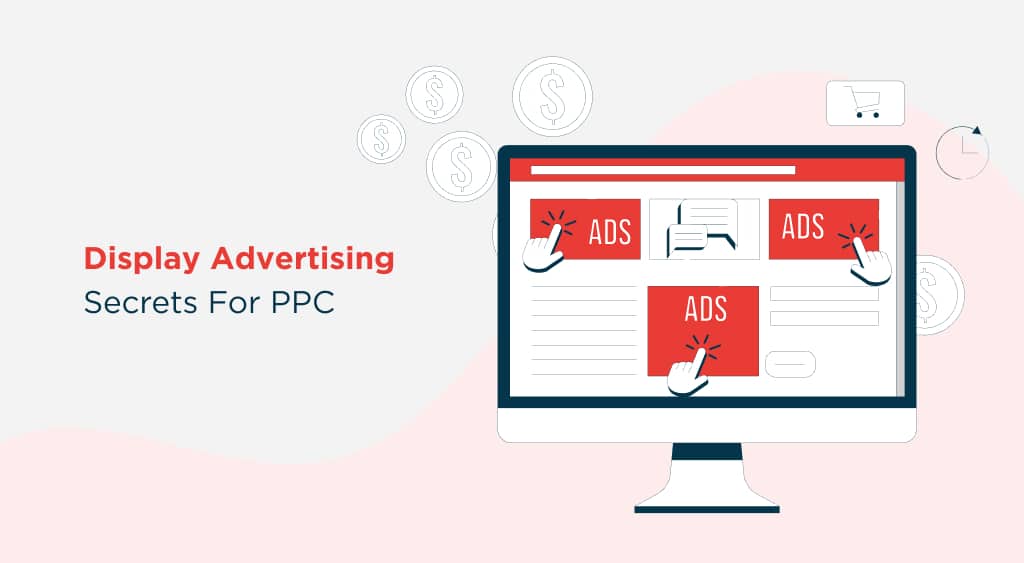Display Advertising Secrets for PPC
30 Dec 2024 | 7 min read
Understanding Display Advertising in PPC
Imagine walking through a bustling market street, your eyes darting from stall to stall. That’s like surfing the web, with display advertising being the colorful, vibrant website looking for your attention. These ads are the visuals that leap out at you, whispering (or sometimes shouting) about an exciting offer or a must-have product.
What is Display Advertising?
Online display ads are the digital banners that line the virtual walls of websites, attempting to catch your eye. They’re not just words on a page; they’re full-color, dynamic spectacles often tailored just for you based on what the advertisers think you might like.
The Role of Display Advertising in PPC
And how do these market banners fit into the bigger picture of pay-per-click advertising? Well, think of PPC as the entire ecosystem of the marketplace. While many vendors shout out their deals to passersby (similar to search ads that pop up when you’re explicitly looking for something), those vibrant banners are for the people just strolling through, not looking for anything in particular. These display ads enhance the ecosystem, ensuring that even those not actively searching still leave with something, perhaps an idea or an interest sparked by a well-placed, well-timed ad.
Benefits of Display Advertising
Display advertising is a powerful PPC tool, offering numerous benefits for businesses looking to maximize their online presence. Let’s explore some key advantages of display advertising: increased brand visibility, targeted audience reach, and diverse ad formats.
Increased Brand Visibility
Display advertising ensures your brand is seen far and wide, illuminating your presence. It’s about something other than shouting the loudest but being seen in the right places where your audience is already looking.
Targeted Audience Reach
With display advertising, you can become the host of a virtual gathering, inviting only the people who share your interests. This precise targeting feels less like a broadcast and more like a conversation in a room full of potential customers inclined to listen to what you have to say.
Diverse Ad Formats
The internet is your gallery, and your ads are the artwork. Display advertising offers you a variety of formats to choose from like an artist selecting their medium. Whether you prefer the classic appeal of a still image or the dynamic engagement of a video, these formats are your tools to express your brand’s story in a way that resonates with your audience.
Creating Effective Display Ads
To make the most out of your display advertising campaign, it’s essential to create compelling visual designs, include a clear call-to-action, and ensure relevance and context in your ads.
Compelling Visual Design
Utilize a color palette that mirrors the values of your brand—calming blues, energizing reds, or optimistic yellows—and imagery that tells your story at a glance. Remember, the visual design of your ad should whisper into the viewer’s eye, “Here’s something you’ll want to see.”
Clear Call-to-Action
Use actionable language that’s concise, using verbs like ‘Start,’ ‘Discover,’ or ‘Join.’ The CTA button is like the door handle to your shop; it should be inviting enough that people can’t resist turning it.
Remember, your display ad bridges the customer’s needs and your solutions. Dress it smartly and guide them confidently across.
Relevance and Context
Have you ever been to a themed party where one person didn’t get the memo and showed up in a costume that was entirely out of place? That’s a faux pas you want to avoid with your display ads. They need to match the environment they’re placed in, targeting users based on their interests or the content they’re consuming. If your ad relates to the website it’s on and the interests of its audience, it won’t stick out like a sore thumb. Instead, it will blend seamlessly into the user’s browsing experience, like the perfect outfit at a themed event.
Each element of an effective display ad—visual design, CTA, relevance, and context—must work harmoniously. It’s like a choir where each voice complements the others, resulting in a beautiful melody that resonates with the listener. When these elements are combined skillfully, your display ads won’t just be seen—they’ll perform.
Targeting Strategies for Display Advertising
To maximize the effectiveness of display advertising in your PPC campaigns, employing targeted strategies is crucial. By focusing on specific audience segments, you can increase the relevance and impact of your display ads. Three common targeting strategies in display advertising are demographic targeting, behavioral targeting, and contextual targeting.
Demographic Targeting
Imagine you’re throwing a party, and you want the right mix of people. Demographic targeting lets you send invites based on specific criteria: age, gender, occupation, income, etc. For instance, if you’re selling luxury watches, you might target professionals over 30 with a higher income. It’s about placing your ads in front of people who fit the profile of your ideal customer, much like curating your guest list to ensure a successful soiree.
Behavioral Targeting
Now, think of a detective meticulously piecing together a profile of someone’s habits and preferences. Behavioral targeting does precisely this for your ads. It tracks and analyzes online behavior – what sites users visit, what content they read, and what they search for – to predict what they might want next. If someone has been looking at many cooking websites, they might start seeing ads for a gourmet spice collection. It’s about anticipating needs based on actions, like a chess player thinking several moves ahead.
Contextual Targeting
Finally, picture a street vendor who sets up shop in different neighborhoods based on what they sell. Contextual targeting places your ads on websites that are relevant to your product. If you’re selling yoga mats, your ads would appear on fitness or wellness sites. This way, you’re talking to an audience already interested in related topics, much like a vendor who knows what street corner they’ll find the most fruit lovers on.
In essence, each strategy is about making sure your ads aren’t just casting a wide net but are strategically placed where they’ll find the right audience at the right time. Like a skilled matchmaker, good targeting introduces your brand to those most likely to take interest, leading to relationships where both parties benefit.
| Targeting Strategy | Description |
| Demographic Targeting | Tailor ads based on age, gender, income, education, and location. |
| Behavioral Targeting | Reach users based on their online behavior, interests, and past interactions. |
| Contextual Targeting | Display ads on websites and platforms that are contextually relevant to your offering. |
Optimizing Display Advertising Campaigns
To maximize the results of your display advertising campaign, it’s essential to optimize and refine your strategies continuously. In this section, we will explore three essential optimization techniques: A/B testing ad variations, tracking and analyzing performance metrics, and refining targeting and placement.
A/B Testing Ad Variations
By creating two versions of your ad (A and B), you can experiment to see which design, headline, or call-to-action gets the best response. This isn’t about wild guesses; it’s about making informed decisions based on real feedback, much like a chef refining a recipe until it’s right.
Tracking and Analyzing Performance Metrics
This is the equivalent of keeping a gardening journal. You need to know what’s thriving and what’s not. By closely monitoring metrics such as click-through rates, conversion tracking, and bounce rates, you gain insights into how well your ads are performing. Think of it as the scoreboard of your advertising game, telling you which plays are scoring points and which ones need to be changed.
Refining Targeting and Placement
Imagine you’re planting seeds in your garden. You wouldn’t just scatter them randomly; you’d place them where the conditions are best for growth. The same goes for your ads. Use the data from your tracking to refine who sees your ads (targeting) and where they see them (ad placement). Your ads do better on certain sites, times of day, or with particular demographics. By honing these aspects, you ensure the soil is just right for your ads to take root and flourish.
In the grand scheme, optimizing your display ad campaigns is about fine-tuning. It’s a continuous process of testing, measuring, learning, and adjusting – all to ensure that your advertising efforts are not just seen but are also impactful and effective.
Best Practices for Display Advertising Success
To achieve optimal results with display advertising in PPC, it’s essential to follow best practices to enhance your campaign’s effectiveness. By implementing these practices, you can maximize the impact of your ads and increase your chances of success. Here are three essential best practices to consider:
Consistent Branding
Your brand is the story you tell the world. Just as a good story stays with you, weaving through your thoughts, your branding should linger in the minds of your audience. Ensure your logo, color scheme, and messaging harmonize across all ads.
Ad Placement Considerations
Placing your ad is like finding the perfect spot—location matters. You don’t want to be too close to the overwhelming content or too far from the irrelevant spaces. Your ads need to find their sweet spot where your audience naturally. Whether it’s a popular blog, a niche forum, or a high-traffic website, ensure your ad placement aligns with your audience’s interests and behaviors.
Monitoring and Adjusting Campaigns
Use analytics as your monitoring tool. Dig into the data to see what’s growing and what’s not. Monitor your ads’ performance meticulously. Look at the click-through rates, the conversion rates, and the overall engagement. Adjust your strategies based on what the numbers tell you. Sometimes, a slight change in the ad copywriting or design can turn a wilting campaign into a flourishing one.
